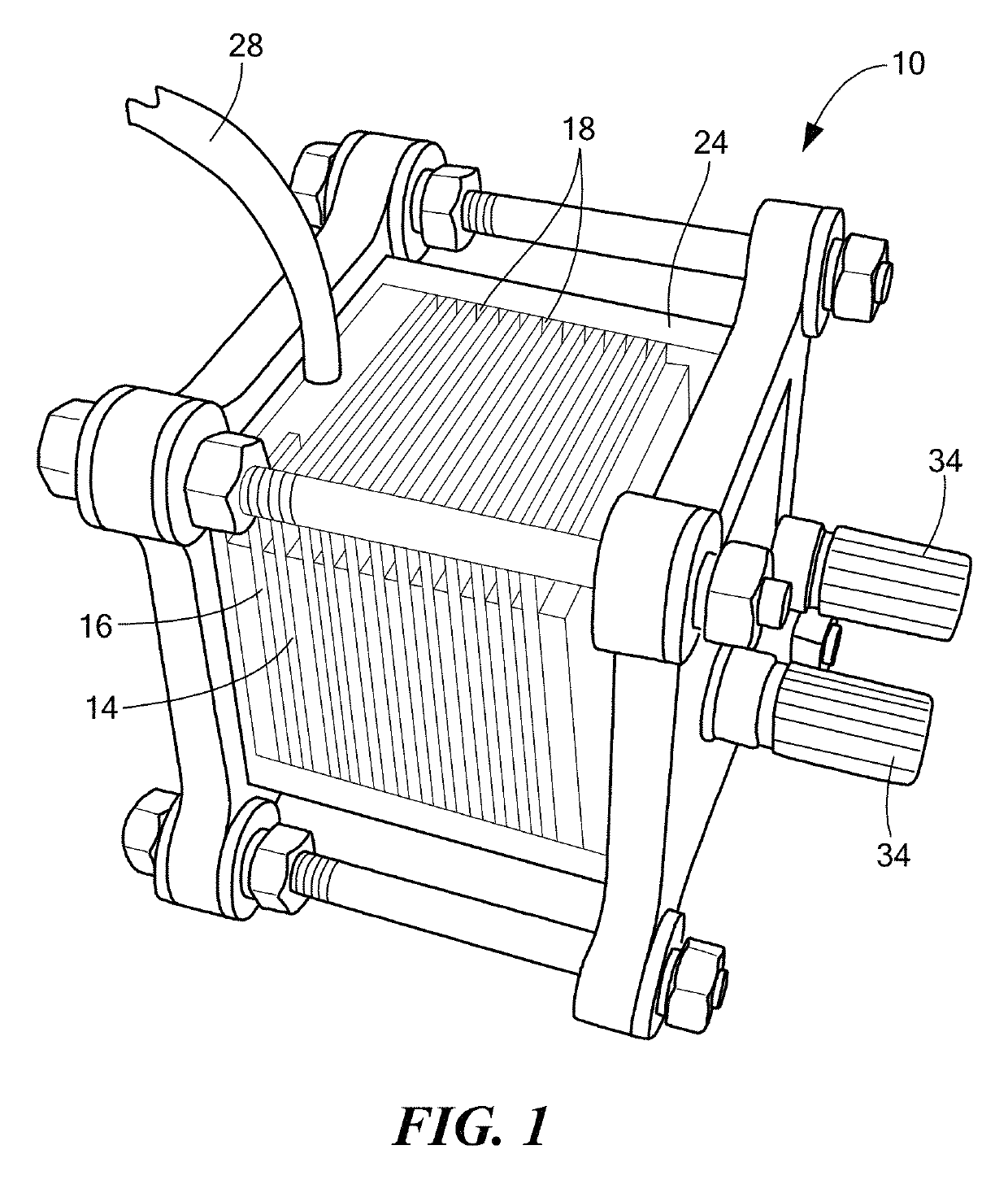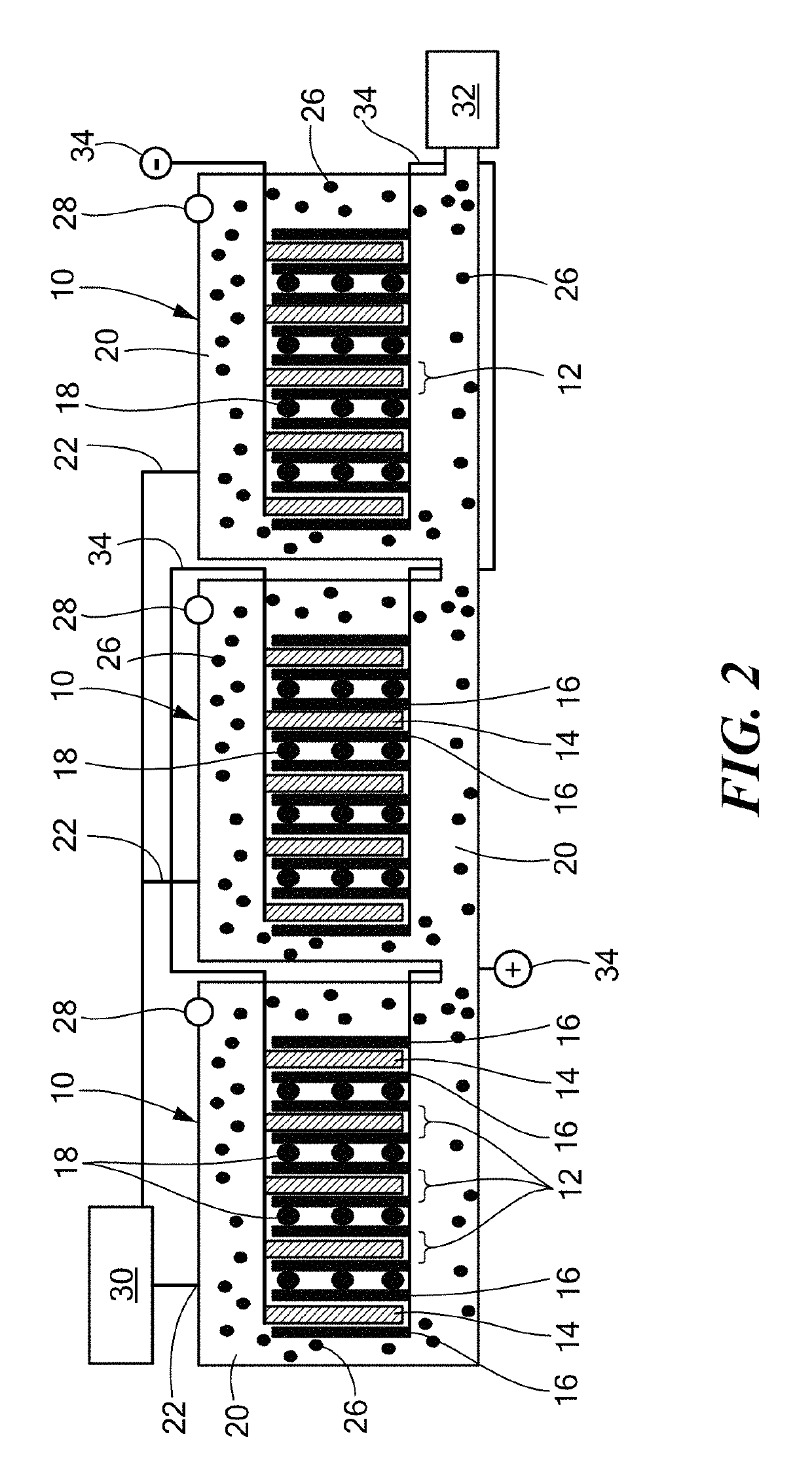Anaerobic aluminum-water electrochemical cell
an electrochemical cell and aluminum-water technology, applied in the field of electrochemical cells, can solve the problems of undersea devices, severe limitations, and efficient energy conversion
- Summary
- Abstract
- Description
- Claims
- Application Information
AI Technical Summary
Benefits of technology
Problems solved by technology
Method used
Image
Examples
example 3
lectrolyte Compositions
[0056]Electrochemical cells were constructed using an Al—Ga anode and Pt cathode with various electrolyte mixtures. The following performance metrics were measured for the electrolyte mixtures:
[0057]
TABLE 1ElectrolyteICorr / ISCVOC (V)ISC (mA / cm2)5M HCl (H2O).71.21-1.6 1405M NaOH (H2O).61.21-1.5594.5M KOH (EtOH).021.51.45M KOH (MeOH).01 1.1-1.5512KOH (BMIM-Tf2N)01.72.002AlCl3 (BMIM-PF6)00.9 .4
In Table 1, ISC is the short-circuit current, VOC is the open-circuit voltage, and Icorr is the corrosion current.
Example 4: Small Reactor Cell (44 mm3)
[0058]An electrochemical cell was constructed using Al99.7Ga0.15In0.15 anodes and platinized titanium cathodes with an 0.5M KOH in H2O40Methanol20Acetonitrile40 electrolyte, as shown in FIG. 1. This cell produced about 1.9 W / L power density, 3.7 MJ / L (@1.2 W / L) energy density, and had a neutral buoyancy of about 1.2 g / cm3. FIGS. 9A and 9B show the performance curves for the cell that was run for about 30 hours.
example 5
ctor Cell (330 ml Cylinder)
[0059]An electrochemical cell was constructed using Al anodes and Ni (Ni electroplated on carbon) cathodes with a 1M KOH (aq) electrolyte, as shown in FIG. 6. This cell produced about 6 W / L power density and 5 MJ / L (@1.2 W / L) energy density. FIGS. 10A and 10B show the performance curves for the cell that was run for about 30 hours.
example 6
Aqueous Electrolytes
[0060]An electrochemical cell was constructed with Al0.998Sn0.001Mg0.001 anodes, Ni (Ni electroplated on carbon) cathodes, and an alkaline aqueous electrolyte at a number of KOH concentrations. For each KOH concentration, the power density of the cell was measured at different voltages and the measurements were plotted in FIG. 13, revealing an increase in performance directly proportional to the electrolyte KOH concentration. This observation is consistent with the cell generating current by the electrochemical pathway described above in Example 2, where higher hydroxide base concentrations facilitate the transport of hydroxide ions and removal of spent reactants while preventing or reducing reaction of water directly with the aluminum fuel in the anode, thereby increasing the power output and reducing the corrosion rate of the fuel cell.
[0061]As illustrated FIG. 14, which is a plot of the measurements obtained with KOH 0.1 M at a higher resolution than in FIG. 1...
PUM
| Property | Measurement | Unit |
|---|---|---|
| energy density | aaaaa | aaaaa |
| discharge efficiencies | aaaaa | aaaaa |
| concentrations | aaaaa | aaaaa |
Abstract
Description
Claims
Application Information
 Login to View More
Login to View More - R&D
- Intellectual Property
- Life Sciences
- Materials
- Tech Scout
- Unparalleled Data Quality
- Higher Quality Content
- 60% Fewer Hallucinations
Browse by: Latest US Patents, China's latest patents, Technical Efficacy Thesaurus, Application Domain, Technology Topic, Popular Technical Reports.
© 2025 PatSnap. All rights reserved.Legal|Privacy policy|Modern Slavery Act Transparency Statement|Sitemap|About US| Contact US: help@patsnap.com



